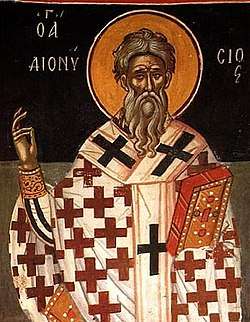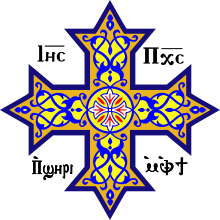Pope Dionysius of Alexandria
| Saint Dionysius the Great | |
|---|---|
| Pope of Alexandria & Patriarch of the See of St. Mark | |
 Pope Dionysius the Great | |
| Papacy began | 28 December 248 |
| Papacy ended | 22 March 264 |
| Predecessor | Heraclas |
| Successor | Maximus |
| Personal details | |
| Born | Alexandria, Egypt |
| Died |
22 March 264 Egypt |
| Buried | Church of the Cave, Alexandria |
| Nationality | Egyptian |
| Denomination | Coptic [1] (Before the Split from the rest of the Orthodox Church.) |
| Alma mater | Catechetical School of Alexandria |
| Sainthood | |
| Feast day | 17 November |
| Venerated in |
Roman Catholicism Eastern Orthodoxy |
| Title as Saint | Martyr |
Saint Dionysius of Alexandria, named "the Great," 14th Pope of Alexandria & Patriarch of the See of St. Mark from 28 December 248 until his death on 22 March 264, after seventeen years as a bishop. Most known information about him comes from Dionysius' large surviving correspondence. Only one original letter survives to this day; the remaining letters are excerpted in the works of Eusebius.
Called "the Great" by Eusebius, St. Basil, and others, he was characterized by the Catholic Encyclopedia as "undoubtedly, after St. Cyprian, the most eminent bishop of the third century... like St. Cyprian, less a great theologian than a great administrator."[2]
Early life
Dionysius was born to a wealthy pagan family sometime in the late 2nd, or early 3rd century. He spent most of his life reading books and carefully studying the traditions of heretics. He converted to Christianity at a mature age and discussed his conversion experience with Philemon, a presbyter of Pope Sixtus II.[2] Dionysius converted to Christianity when he received a vision sent from God; in it he was commanded to vigorously study the heresies facing the Christian Church so that he could refute them through doctrinal study. After his conversion, he joined the Catechetical School of Alexandria and was a student of Origen and Pope Heraclas. He eventually became leader of the school and presbyter of the Christian church, succeeding Pope Heraclas in 231. Later he became Pope of the Coptic Orthodox Church of Alexandria & Patriarch of the See of St. Mark in 248 after the death of Pope Heraclas.[2]
Work as Bishop of Alexandria
Dionysius was more an able administrator than a great theologian.[2] Information on his work as Bishop of Alexandria is found in Dionysius' correspondence with other bishops and clergymen of the third century Christian Church. Dionysius’ correspondences included interpretations on the Gospel of Luke, the Gospel of John and the Book of Revelation.
During 249, a major persecution was carried out in Alexandria by a pagan mob, and hundreds were assaulted, stoned, burned or cut down on account of their refusal to deny their faith. Dionysius managed to survive this persecution and the civil war that followed. In January 250 the new emperor Decius issued a decree of legal persecution. Out of fear many Christians denied their faith by offering a token pagan sacrifice, while others attempted to obtain false documents affirming their sacrifice. Others who refused to sacrifice faced public ridicule and shame among their family and friends, and, if found by the authorities, brutal torture and execution. Many fled from the city into the desert, where most succumbed to exposure, hunger, thirst, or attacks by bandits or wild animals.[3]
Dionysius himself was pursued by the prefect Sabinus, who had sent out an assassin to murder him on sight. Dionysius spent three days in hiding before departing on the fourth night of the Decian decree with his servants and other loyal brethren. After a brush with a group of soldiers, he managed to escape with two of his followers, and set up a residence in the Libyan desert until the end of the persecution the following year.[3]
He supported Pope Cornelius in the controversy of 251, arising when Novatian, a learned presbyter of the Church at Rome, set up a schismatic church with a rigorist position on the readmittance of Christians who had apostasized during the persecution. In opposition to Novatian's teaching, Dionysius ordered that the Eucharist should be refused to no one who asked it at the hour of death, even those who had previously lapsed.[4]
In 252 an outbreak of plague ravaged Alexandria, and Dionysius, along with other priests and deacons, took it upon themselves to assist the sick and dying.[3]
The persecutions subsided somewhat under Trebonianus Gallus, but were renewed under Valerian who replaced Gallus. Dionysius was imprisoned and then exiled. When Gallienus, took over the empire he released all the believers who were in prison and brought back those in exile. Gallienus wrote to Dionysius and the bishops a letter to assure their safety in opening the churches.[5]
Prophetic exegesis
About AD 255 a dispute arose concerning the millennialist views taught in Refutation of Allegorists, by Nepos, a bishop in Egypt, which insisted on the interpretation of Revelation 20 as denoting a literal "millennium of bodily luxury" on earth. Because he was taught by Origen, Dionysius succeeded through his oral and written efforts in checking this Egyptian revival of millennialism. He offered some critical grounds to reject the Book of Revelation, such as an alleged difference in style and diction from John's Gospel and Epistles. Dionysius main position was to claim it was not written by John: " 'I could not venture to reject the book, as many brethren hold it in high esteem,' " yet he ascribed it to another John - some "holy and inspired man" - but not the apostle John.[6]
His impact was felt in later years concerning the canonicity of the Apocalypse, causing much dialogue in the church, lingering in the East for several centuries. Thus it was that certain leaders began to retreat from millennialism in precisely the same quantity as philosophical theology became influential.[7]
Legacy
St. Basil writes to Pope Damasus speaking of aid sent by Pope St. Dionysius, to the church at Caesarea. This correspondence is cited by Pope Pius IX in his encyclical Praedecessores Nostros (On Aid For Ireland) of 25 March 1847.[8]
Footnotes
- ↑ Eusebius of Caesarea, the author of Ecclesiastical History in the 4th century, states that Saint Mark came to Egypt in the first or third year of the reign of Emperor Claudius, i.e. 41 or 43 A.D. "Two Thousand years of Coptic Christianity" Otto F. A. Meinardus p28.
- 1 2 3 4 Chapman, John. "Dionysius of Alexandria." The Catholic Encyclopedia. Vol. 5. New York: Robert Appleton Company, 1909. 6 Apr. 2013
- 1 2 3 "Saint Dionysius", The College of Saint Dionysius
- ↑ Butler, Alban. Lives of the Saints, Vol. XI, 1866
- ↑ "The Story of Abba Dionysius", Coptic Orthodox Church
- ↑ Eusebius. "25". Church History. 7. p. 309.
- ↑ Froom 1950, pp. 325–326.
- ↑ Pope Pius IX, Praedecessors Nostros, 25 March 1847
References
- Froom, LeRoy (1950). The Prophetic Faith of our Fathers (DjVu and PDF). 1.
External links
- Works by Saint Dionysius at Project Gutenberg
- Works by or about Saint Dionysius at Internet Archive
- The works of Gregory Thaumaturgus, Dionysius of Alexandria and Archelaus, trans. S. D. F. Salmond, Edinburgh, T. & T. Clark, 1871: Google Books, archive.org
- Letters of Dionysius of Alexandria to the Popes Stephen and Xystus (tertullian.org)
- Bishop of Alexandria, Saint Dionysius, "St. Dionysius of Alexandria Letters and Treatises", edited by Charles Lett Feltoe, The MacMillin Company, London, 1918
| Titles of the Great Christian Church | ||
|---|---|---|
| Preceded by Heraclas |
Pope and Patriarch of Alexandria 248—264 |
Succeeded by Maximus |
